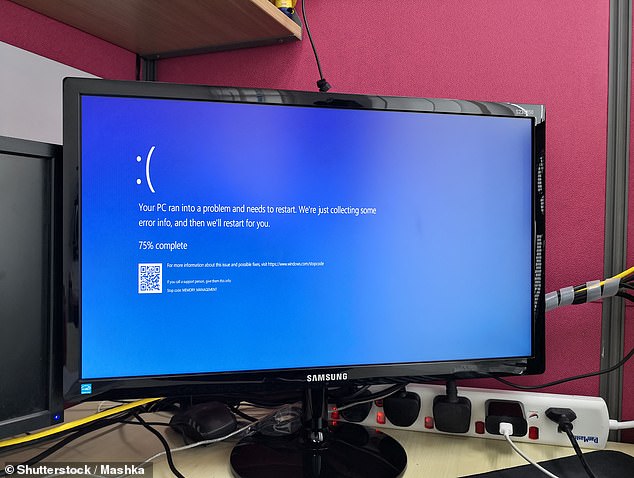What caused the Microsoft’s global outage? CrowdStrike software failure causes banks, airlines and hospital systems to go down
Americans have fallen victim to the “mother of all outages” after Microsoft suffered a meltdown on Friday.
Hundreds of thousands of Windows computers went offline or got stuck on so-called ‘blue screens of death’.
Banks, airlines, television networks, trains and health care facilities reported widespread outages from around 2 a.m. Eastern Time.
The chaos was caused by a bug in a single content update from Crowdstrike, an American cybersecurity firm used by Microsoft, the company reported at 5:30 a.m. ET.
Analysts told DailyMail.com that Crowdstrike assured the public the outage was not the result of a cyberattack and that it could take up to 36 hours to resolve.
Crowdstrike assured the public that the outage was not caused by a cyberattack and said it was “actively working with customers” who were affected
What happened?
The global computer outage started at Microsoft, leading people to believe the company’s systems were the cause. However, a few hours later, it turned out that Crowdstrike was the culprit.
Crowdstrike, an Austin-based cybersecurity specialist, provides software to 29,000 companies and industries to protect their online systems from cyberattacks and security breaches.
The outage at Microsoft was caused by a bug in Crowdstrike’s software update, which was implemented in the ‘Falcon Sensor’, which scans for viruses and malicious attacks.
“One of the tricky things about security software is that it needs absolute permissions over your entire computer to do its job,” Thomas Parenty, a cybersecurity consultant and former National Security Agency analyst, told the New York Times.
“So if something goes wrong with it, the consequences are much greater than if your spreadsheet doesn’t work.”
The incident impacted Microsoft’s 365 Apps and Azure services, which are used by more than 50 percent of the Fortune 500 and eight of the largest financial institutions in 43 U.S. states.
Microsoft 365 is a cloud platform that helps businesses protect themselves from cyberthreats and keep information about shared files, emails, and links secure and private.
The Defender for Office app helps prevent, detect, and respond to phishing and ransomware threats.
Azure is a cloud firewall security service that provides protection against threats to files, data, and other apps.
How has the outage affected airlines, banks and other businesses?
Millions of passengers were stranded at airports as major airlines grounded their planes due to the Crowdstrike outage.
Airlines including Delta, United and American grounded all planes, leaving millions of people stranded in airports around the world.
Public transit systems in New York City and Washington, D.C. caused delays across the city as arrival times for many routes were not available at stations and in apps.
“This technical glitch impacts our ability to see the location of trains, so we are unable to provide that information,” NYCT Subway said. wrote on X.
Airlines rely on Microsoft systems for virtually all of their technology, from traffic control and check-in counters to scanning passenger boarding passes. All of these systems were affected by the outage.
The New York Port Authority is warning customers not to travel to nearby airports unless they have received confirmation that their flight will depart on time.
Major government agencies, including the Social Security Administration, were forced to close their doors. The agency said the incident had disrupted numerous services.
The company said wait times for the national 800 number will be longer than normal and some online services will be unavailable.
The system outage also impacted TD Bank, Visa and Bank of America, as customers struggled with not getting their money back until systems were restored.
Meanwhile, 911 centers and other emergency centers have also been shut down in several states, including Alaska, Ohio, Texas and New Hampshire. However, it is still unclear how big the problem is.
Hospitals in the US were also hit, having to turn away patients and postpone or reschedule procedures.
Harris Health Quentin Mease Health Center in Houston said it was canceling all elective procedures and outpatient care, while Mass General Brigham in Boston said The Boston Globe that ‘all previously scheduled non-urgent surgeries, procedures and medical visits are cancelled today.’

Crowdstrike, an Austin-based cybersecurity specialist, provides software to 29,000 customers to protect their online systems from cyberattacks and security breaches. The outage occurred after the company deployed its “Falcon Sensor” software, which caused all computers running Microsoft Windows to crash, with airlines being hit the hardest.
What is Crowdstrike doing to resolve the issue?
Crowdstrike is currently working with customers affected by the Falcon Sensor update and the company’s CEO, George Kurtz, Posted on X that it did not impact customers using Mac and Linux hosts.
“This is not a security incident or cyberattack. The problem has been identified, isolated, and a fix has been implemented,” Kurtz said.
‘We refer customers to the support portal for the latest updates and continue to provide full and ongoing updates on our website.
‘We also recommend that organizations ensure they communicate with CrowdStrike representatives through official channels.
“Our team is fully mobilized to ensure the safety and stability of CrowdStrike customers.”
The cybersecurity firm has advised companies to manually restart each computer in safe mode, delete a specific file and then restart the computer normally.
“There is a workaround, but it requires you to manually modify Windows system files in recovery mode,” Lukasz Olejnik, an independent cybersecurity researcher and consultant, told the NY Times.
‘Such a practice is generally discouraged, as errors can cause other problems.’
The company didn’t specify when all services are expected to be available again, but Microsoft 365 said: “Our services are continuing to improve as we continue to take steps to mitigate the issue.
“We still expect that users will experience gradual relief as we continue to address the issue.”
Tech market analyst Dan Ives told DailyMail.com that the global outage is “a massive disaster” and that it will take “24 to 36 hours before everything is fully under control.”
